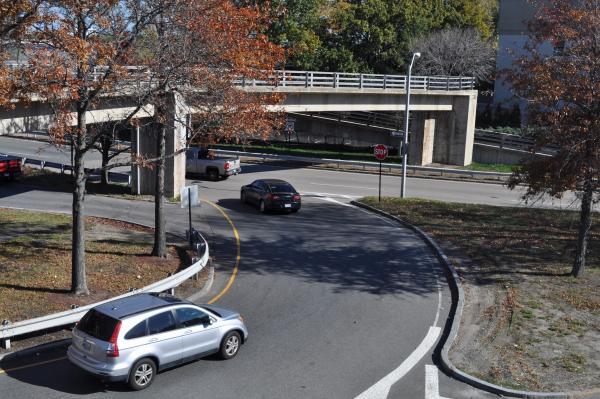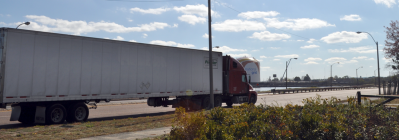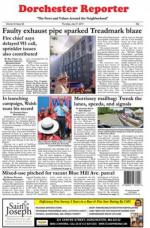November 3, 2016

A plan to eliminate this u-turn near Pope's Hill is one element of the Morrissey Boulevard re-design plans that caught the attention of residents. Photo by Bill Forry
A state plan to beautify and fortify Morrissey Boulevard is getting both up and down reactions from neighborhood residents who’ve studied the conceptual designs, according to a Reporter look at public comments submitted to the Department of Conservation and Recreation (DCR) over the last month.
The feedback from more than 30 residents— most of them from Dorchester— was delivered to the DCR mainly through its website and via emails in the wake of a presentation made at the Murphy School in September.
At the meeting, DCR officials summarized their latest plans for the three-mile-long thoroughfare that connects Neponset Circle to Columbia Point and serves as a vital north-south route into and out of the city’s core. The project would include reducing vehicular travel lanes from three to two in key sections, allowing for dedicated bicycle and pedestrian paths. It would also lower the speed limit from 40 mph to 35 mph and install new traffic signals and trees to convert the traffic-laden boulevard into a more user-friendly parkway.
The project could eventually cost more than $40 million— funds that have not yet been fully committed in the state budget. But the DCR has $3.2 million to begin the work, including the planning and design phase— which is still very much in its early stages.
Many neighbors who submitted comments before the Oct. 18 deadline were complimentary— hailing the concept of improving the boulevard as both worthwhile and overdue.
But there were also concerns expressed about details like the proposed elimination of the U-turn at the Dunkin’ Donuts shop at the foot of Pope’s Hill.
David Matton, a resident of Mill Street in Clam Point, worries that a current plan to eliminate the cross-over underneath a pedestrian overpass is a bad idea that will force Dunkin Donuts plaza and Pope’s Hill traffic that is headed north-bound “to travel 2,200 feet south to a U-turn at a location with very poor sight distance.”
On the positive side, Stephen O’Malley one of several Port Norfolk residents who chimed in with comments, wrote: “I think the whole plan for the redesign is a great idea. The cars drive on the boulevard like it’s a highway. My biggest concern —and what I haven’t noticed — is any safe places for any kids to cross the boulevard.”
Added Tim Czerwienski, who also lives in Port Norfolk: “The designs for Morrissey Boulevard, relative to pedestrians and bicyclists, look great and are a long time coming.” He sees more and more cyclists cutting through his neighborhood to access the Neponset Greenway and Morrissey. “Even some small amount of signage or painted bike lanes between the river and the circle would go a long way to protect cyclists, pedestrians, and drivers.”
Many of those who responded are bicyclists who describe the current road system as hazardous. Almost every one of them emphasized the need for a safe connection between the Neponset Greenway trail, which terminates near Tenean Beach, and the Dorchester Harborwalk that circuits Columbia Point.
“Morrissey is really dangerous,” wrote Noah Augustine, a student at UMass Boston who lives in Uphams Corner. “It would be wonderful to see it redesigned with a separated, safe and protected bike lane. This could be an area of major attraction if there was a decent bike path, as it goes right along the water and connects parts of southern Dorchester to the rest of the city.”
Lee Toma, who wrote on behalf the Milton Bicycle Advisory Committee, applauded the emphasis on bike and pedestrians, but wants the agency to go further by making bikeways even wider and by designing travel lanes to encourage motorists to use the I-93 expressway instead of Morrissey. As the boulevard grows in density— with new projects likely including the redevelopment of the Boston Globe site— Toma wants the state to anticipate more people and more bicycles.
“The UMass train station is a popular destination, and will likely be even more so as the new condos open and the Globe and WLVI sites are redeveloped,” he wrote. “A wider, two-way cycle-track would be much more useful than a one-way route. I suggest eliminating the new trees from the secondary median, and/or making the travel lanes and buffer narrower.”
Savin Hill resident Kathleen Schnaidt is “so happy to see the reduction of car lanes and the addition of good walk/bicycle lanes. I like the vision of it as a parkway with emphasis placed on access to the beach and parklands for bikers and walkers. I would ride/walk on [Morrissey Boulevard] much more frequently if it didn’t feel like a speedway dominated by cars. I would applaud any efforts to slow the traffic. I also appreciate the addition of trees and landscaping – to make it more visually beautiful and to also help ameliorate the effects of car exhaust. I’ve heard some say that it isn’t used much by bikers, so bike lanes aren’t needed. It isn’t used much because it is currently unpleasant and unsafe to bike on.”
Conevery Valencius of Quincy said he commuted to his job at UMass Boston by using the MBTA instead of a more direct option of bicycling to Columbia Point out of concern for his safety. “These redesign elements would address my concerns: they are vital and need to happen soon!” he wrote. “As our city’s only public university continues to grow – and continues to suffer severe constraints on parking and access – we have the chance to connect two important objectives: supporting public education and encouraging more bike commuting.”
Britt Hartet of Fields Corner said the current boulevard is too wide and too fast and effectively cuts “Dorchester off from the waterfront and [makes] it far too dangerous and difficult to navigate by any means other than car. I live at Fields Corner and work in the Seaport. I would like to bike along Morrissey up through South Boston, but it is too inconvenient. This forces me onto Dorchester Avenue which is also very dangerous. I would bike commute significantly more if options were safer.”
Others, like David Matton, weighed in with demurrers.
Maria Lyons, a longtime Port Norfolk activist who is a member of the Neponset Greenway Council, wrote that she is “all for trees, walkways and bike tracks, but this plan goes too far and adds unnecessary costs.” In particular, Lyons objects to taking away a vehicular travel lane northbound, which is outlined in the plan.
“Taking away [a vehicle] lane will cause extreme backups in all of East Dot, Quincy, Milton. Your traffic estimates are too low and you are not accounting for future condo development,” Lyons wrote. “If there is a two-way cycle track on southbound side, plus a side road bike track on the north side, there is no need of taking travel lane for another bike track.”
Lyons added: “If you want to make Morrissey more neighborhood friendly, you need to add more cross streets that will allow car passage across and slow down traffic. Port Norfolk needs another safe way to get out of the area.” She urged engineers to conduct new traffic studies during rush hours on a Tuesday.
“At the very least, you need to test your plan by taking away lanes and changing light timings and see what happens,” she wrote.
Geoffrey Bok of Port Norfolk is also worried about eliminating that u-turn at the Dunkin’ Donuts plaza.
“In so doing you have made it impossible (or at least very difficult) for a car going southbound on Morrissey Boulevard from the stores and Dorchester access streets south of Freeport Street to reach the Port Norfolk neighborhood or Tenean Beach,” he wrote.
“This reduction in access does not accord with the ‘primary project goal’ and the important public need to ‘strengthen connections to recreational facilities, natural resource areas, and neighborhoods,’ ” he added. “If you must remove this “U-turn” — which I think is a mistake — then there needs to be added a legal and safe way for a car to turn left off of Southbound Morrissey Boulevard onto Conley Street.
Indeed, Conley Street should have both a Northbound and Southbound Morrissey Boulevard entrance and exit, so as to serve properly as a means of access to and from the Port Norfolk neighborhood and Tenean Beach.”
William Bonnice of Uphams Corner seconded his neighbors’ concerns about the U-turn. “Whenever I go to Lamberts or Stop & Shop, it is how I got home. What are the proposed alternatives?” he asked.
Edward McCarthy, of Port Norfolk section, claims that “from the outset this process has been hijacked by special interest groups, specifically, cyclists. It strikes me that the DCR is proposing to spend millions of dollars to placate a very small, albeit vocal, group. Your own data clearly states that Morrissey Boulevard is not utilized by cyclists, yet is used by thousands of people everyday to go to work, travel home, and generally live their lives.
“Yet, instead of dealing with the issue, that being improving the movement of traffic, your solution is to actually make traffic worse by taking lanes away. It is utterly preposterous to believe that by doing this you are going to force people onto a highway already past the point of saturation. What you will succeed in is creating additional traffic on secondary and neighborhood roads as people seek alternative routes.”
McCarthy also worries that the re-design will further limit access to the Port. “Fire, police, and EMS has a difficult enough time in accessing our neighborhood as it is,” he wrote. “Delays, even in seconds, can mean the difference between life and death. There was also no mention on the negative effects this will have on the many business in the area.”
Donna Bishop of Port Norfolk sent a letter that called into question the wisdom of the planning itself. “There is nothing ‘difficult’ about travel on the Boulevard,” she wrote. “There are never any pedestrians and no matter how beautiful you might make it, there will still be no reason for foot traffic. The reason Morrissey Boulevard is busy is because Route 93 is so overcrowded much of the time that people try to avoid it. Your plans will make Route 93 and all local roads, including Morrissey Boulevard, intolerable.”
Other comments included innovative ideas for improving the aesthetics along the parkway. Al Knasas of Dorchester wants engineers to incorporate “dark sky” solutions for lighting along the stretch of the boulevard between Freeport Street and UMass.
“The new lighting for this tract would be concentrated downward onto the sidewalk/bicycle paths being proposed and allow that lighting to wash onto the roadway preserving and enhance the unique visual of the night sky in this area,” he wrote. “This may also allow for the lamp posts to be located farther from the roadway reducing the lamp posts taken out by auto accidents.”
Heidi Moesinger of Savin Hill offered a similar idea to reduce “light pollution. Please consider indirect/reflective lighting technology,” she wrote. “I’ve seen this type of lighting along the new walkway between the JKF Library and Harbor Point. There are no shadows, no glare, and minimal light pollution. It is easier on the eyes and makes seeing at night easier. You can’t see the bulb because it is inside the fixture, pointing up to a type of hat cover that reflects the light downward, spreading it nicely and without any shadows, which seems like an amazing magic trick.
Hammad Ahmed of Jones Hill wants to see state planners look to the rails to help ease commuter woes. “A Red Line stop somewhere between JFK and North Quincy,” offered Ahmed. “Potentially a stop at the traffic circle where Morrissey goes under the tracks.”
Evan Brinkman is for a new T station as well. “Pope’s Hill T Station should be brought back!” wrote Brinkman. “Or at least flexibility should be in the design in case it ever is.”
Paul Nutting of Savin Hill, a longtime advocate for improvements along Morrissey and Dorchester’s waterfront, offered his own plan to add three new intersections to the plan. One would connect Conley Street to Freeport near the Stop and Shop to “allow residents of Port Norfolk to easily access other parts of Dorchester.”
Secondly, Victory Road should be rejoined to “take a lot of pressure off of the Freeport Street intersection by allowing many more routing options. It also would reduce cut-through traffic on the Clam Point side streets.”
Nutting also wants to plan for a “future road that is called for in the Columbia Point master plan. This new road is part of a long term solution to congestion at K-Circle and could possibly be paid for by the Globe developer or as part of a Bayside development. It would be prudent to account for this in your planning.”
 Trucks are banned from boulevard
Trucks are banned from boulevard
Trucks are not supposed to use Morrissey Boulevard, but it’s not unusual to see tractor trailers— like this one shown on Tuesday afternoon— barreling down the roadway. Savin Hill’s Heidi Moesinger wants to new design of the boulevard to include “something up like the have on Storrow Drive.” She says: “The neighborhood is concerned about trucks on this road, particularly in the middle section by the bridge.” Photo by Bill Forry
Topics:



